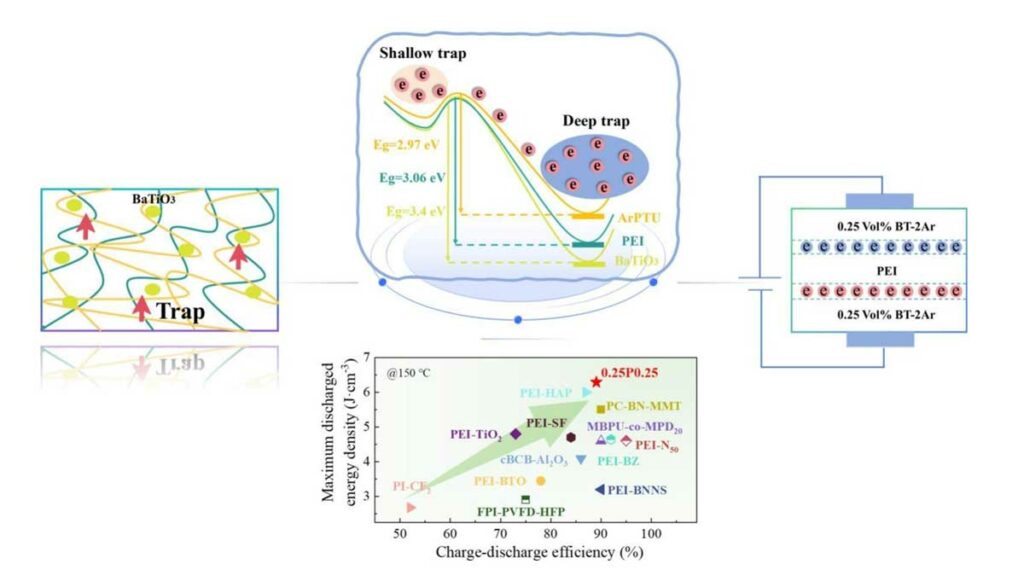Team of researchers from China and Spain published article Breaking the energy density barrier in polymer film capacitors via molecular and interfacial design in Journal of Colloid and Interface Science that introduces new ways to achieve high energy density film capacitors while maintaining its efficiency up to 150°C.
Introduction
Polymer film capacitors are prized for fast charge–discharge and high power density, yet their energy density and high‑temperature reliability have been persistent bottlenecks.
This article presents a tripartite design that combines molecularly engineered polythioureas, interfacial band alignment using nanofillers, and a rational sandwich architecture to suppress leakage, homogenize electric fields, and raise breakdown strength.
The result is a notable leap in discharged energy density and efficiency at both room temperature and up to 150°C, addressing the classic trade‑off between thermomechanical stability and dielectric insulation in polymer systems.
further ref article: What is a Dielectric Constant and DF of Plastic Materials?
Key points
- Problem focus: Low energy density and thermal leakage in polymer dielectrics limit miniaturization and high‑temperature operation.
- Molecular design: Tailored thiourea‑based polymers (ArPTU, MePTU, MetaPTU) modulate free volume and charge distribution in PEI, decoupling thermal stability from electrical insulation.
- Interfacial engineering: BT nanofillers create rectifying heterointerfaces with deep carrier traps, suppressing field distortion and conduction losses.
- Structural strategy: A sandwich architecture homogenizes electric fields and improves breakdown strength, synergizing with interfacial effects.
- Performance gains: Discharged energy density of 7.33 J/cm³ at 660 MV/m with 90.0% efficiency (RT), and 6.29 J/cm³ at 620 MV/m with 89.1% efficiency (150 °C).
Extended summary of the article
The authors target the central barriers to high‑energy polymer dielectrics: temperature‑driven leakage, reduced bandgaps in aromatic backbones, and field inhomogeneities that precipitate early breakdown. While polymers like BOPP are industrial workhorses, their efficiency collapses above ~105 °C due to sharp rises in leakage current. The work reframes material selection around bandgap engineering and interfacial rectification, aiming to suppress charge injection and transport under strong fields and heat.
A series of polythiourea frameworks—aromatic (ArPTU), methylene‑bridged (MePTU), and meta‑phenylene‑bridged (MetaPTU)—are synthesized to tune free volume and electrostatic interactions within a polyetherimide (PEI) matrix. This molecular adjustment optimizes charge distribution without overly compromising the polymer bandgap, a common pitfall of high‑Tg aromatic systems. The ArPTU units, in particular, facilitate effective cross‑linking between BaTiO₃ (BT) nanofillers and PEI, yielding a rectifying effect that curbs disordered charge motion at elevated temperatures.
Nanofiller choice and placement are leveraged to engineer band offsets at the polymer–filler interface. BT induces energy level mismatch that generates built‑in heterojunction electric fields, thereby enhancing carrier scattering and trapping. These deep, high‑density interfacial traps reduce local field distortion and suppress leakage across a broad thermal window. Complementing this, a rationally designed sandwich architecture further homogenizes electric field distribution and shepherds breakdown pathways in‑plane, delaying failure and boosting intrinsic breakdown strength.
The synergy of molecular doping, interfacial band structure control, and multilayer field management manifests in substantial energy storage gains. The optimized sandwich films deliver discharged energy density of 7.33 J/cm³ at 660 MV/m with 90.0% efficiency at room temperature, and 6.29 J/cm³ at 620 MV/m with 89.1% efficiency at 150 °C—benchmarks that underscore robust suppression of leakage and efficient polarization under demanding conditions. These outcomes illustrate a viable pathway to high‑temperature‑stable polymer dielectrics without sacrificing insulation quality, supporting next‑generation capacitor miniaturization and integration in grids and EV power electronics.
The discharged energy density of a linear dielectric under an electric field is:
U = 1 2 ε ₀ ε r E 2Where U is energy density, ε₀ is vacuum permittivity, εᵣ is relative permittivity, and E is the applied electric field. In practice, discharged energy may be reported with efficiency η from polarization hysteresis; the reported values (7.33 J/cm³ at 660 MV/m, 6.29 J/cm³ at 620 MV/m) reflect minimized loss via interfacial traps and field homogenization.
Conclusion
By tightly coupling molecular free‑volume engineering with interfacial rectification and sandwich‑layer field homogenization, the study achieves high energy density and efficiency from ambient up to 150 °C. It resolves the classic Tg–Eg trade‑off through polythioureas, strategically aligns bands with BT nanofillers to trap carriers, and structurally evens fields to raise breakdown strength—together delivering a scalable recipe for high‑performance polymer capacitors in harsh environments.
Read the full scientific paper:
Yang Liu, Yonghao Zhang, Tao Liu, Tiezhu Guo, Weichen Zhao, Tao Zhou, Yao Zhou, Wenfeng Liu, Jordi Jacas, Joan Ramon Morante Lleonart, Andreu Cabot, Di Zhou, Breaking the energy density barrier in polymer film capacitors via molecular and interfacial design,
Journal of Colloid and Interface Science, Volume 703, Part 2, 2026, 139174, ISSN 0021-9797,
https://doi.org/10.1016/j.jcis.2025.139174.
